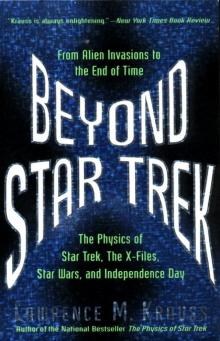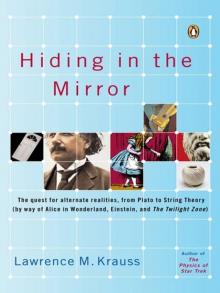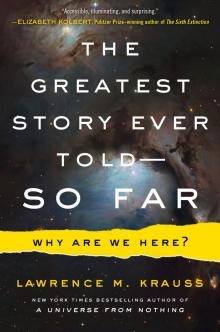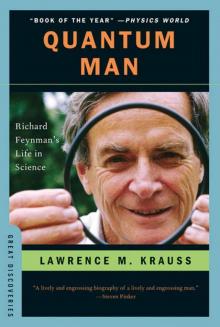- Home
- Lawrence M. Krauss
Quantum Man: Richard Feynman's Life in Science Page 16
Quantum Man: Richard Feynman's Life in Science Read online
Page 16
The net effect of this, Feynman reasoned, was simply to change what we would normally think of as the mass of the helium atom in question. This is because when it moved, more than one helium atom would have to also move out of the way along with it to minimize the action. Everything else would remain the same.
As a result, Feynman demonstrated that the trajectories that contributed most to the sum over paths—that is, the trajectories that had minimum action—would be those in which each particle moved along acting like a free particle, but with a slightly increased mass. The otherwise strong repulsive atomic interaction at small distances could be completely accounted for by this effect and thus otherwise ignored. But if the particles were acting like free particles, then a Bose-Einstein ideal gas picture was a good one, and a Bose-Einstein transition was indeed possible.
That Feynman was able to demonstrate that strongly interacting particles could nevertheless behave, from the point of view of calculating their quantum mechanical behavior, as if they were free particles, clearly had significance for him beyond the case of liquid helium. As he stated in his first paper on the subject, “This principle may have uses in other branches of physics, for example in nuclear physics. Here there is the puzzling fact that single nucleons often act like independent particles in spite of strong interactions. The arguments we have made for helium may apply to this case also.” Feynman was clearly deeply moved by this phenomenon. We will see again and again how his work over the next twenty years or so returned to precisely this situation, where objects that may be strongly interacting can at the same time behave as if they are not.
His interest went beyond nucleons (that is, protons and neutrons) alone. Once again, he was interested in trying to understand the new strongly interacting mesons, where Feynman diagrams appeared to be inadequate. If he could use his physical intuition, combined with the wealth of experimental information on liquid helium, to test new methods to understand strongly interacting systems, maybe he could then apply them to studying mesons. He as much as said this in the next paper he wrote, in 1954. This paper did not involve helium per se, but rather explored the motion of slow electrons in materials that become polarized in their presence, once again using space-time path-integral methods to untangle the physics. Again, in his words, “Aside from its intrinsic interest, the problem is a much simplified analog of those which occur in the conventional meson theory when perturbation theory is inadequate.” And then in another paper almost a decade later: “It is interesting as a phenomenon in solids, but it has an extended interest since it is one of the simplest examples of the interaction of a particle and a field. It is in many ways analogous to the problem of a nucleon interacting with a meson field. . . . It is the strong-coupling aspect of the problem which has aroused so much interest.”
Clearly, while Feynman reveled in the unity of physics—the applicability of understanding phenomena in one realm of the physical universe to understanding phenomena in a distant realm—his continued references over these years to mesons and nucleons suggest that he was always drawn back to the mysteries of the burgeoning subatomic world of elementary particles and their exotic new interactions. He would shortly return to that world, but he had not yet fully solved the problem he had set out for himself—namely, explaining superfluidity and perhaps with it the holy grail of superconductivity—and it was not in his nature to leave a problem he had started before he got the answers he wanted. In so doing, he would help transform the way we understand the quantum behavior of materials.
CHAPTER 12
Rearranging the Universe
Resistance is futile.
—The Borg, to Captain Picard,
in Star Trek: The Next Generation
Feynman had explained how the transition that led to superfluid helium could be understood as a Bose-Einstein–like condensation where all the atoms condensed into a single macroscopically visible quantum state. But that did not solve the problem. The world does not look quantum mechanical to us because the mysterious quantum mechanical correlations at the atomic level that produce all the weird phenomena can be destroyed quickly by interactions with the environment. As a system gets bigger and bigger, the number and variety of these interactions, including now internal interactions between the many constituents, increase, and “quantum coherence” is quickly lost on microscopic timescales. Thus, simply condensing into a macroscopic quantum state is one thing, but why doesn’t the smallest disturbance destroy this state? What keeps superfluid helium a superfluid?
Up until Feynman began to work on this topic, the answers given to this problem were “phenomenological.” In other words, since experiments clearly demonstrated that superfluidity existed, one could extract the general behavior of the system from experimental results and therefore infer what the microscopic physical properties of the system would have to be to reproduce those results. This may sound like a complete physical explanation, but it is not. Deriving microscopic physical properties from experiments is different from explaining why nature produces these properties. This was the goal Feynman set for himself, and he largely achieved it.
Lev Landau had proposed the correct phenomenological model. Landau dominated physics in the Soviet Union with a force of personality and breadth of interest that paralleled Feynman’s, and Feynman respected him tremendously. Indeed, when in 1955 the Soviet Academy of Sciences invited Feynman to attend a conference, meeting Landau was one of the reasons Feynman initially jumped at the chance. Unfortunately, however, cold war tensions caused the State Department to advise him not to go, and he acceded to the request.
Unlike Feynman, whose intellectual “center” seemed to always move back to particle physics, Landau’s remained on the physics of materials, the very area that Feynman was now focusing on. Landau had argued that the persistence of superfluidity implied that there are no other accessible low-energy states near the coherent Bose-Einstein condensate state at low temperature that disturbances could kick the quantum fluid into. A normal liquid has resistance to flow (that is, viscosity) because individual atoms and molecules bounce around hitting other atoms and molecules in the fluid, other impurities, or the container walls. These internal excitations only change the state of motion of individual atoms, but they dissipate energy from the fluid to the container and slow the flow of the fluid. However, if there were no new accessible individual quantum mechanical states for individual particles to be kicked into, then these particles could not change their state of motion as a result of any collisions. Thus the superfluid will continue to move uniformly, just as an electron orbiting an atom continues to do so without dissipating any energy.
What Feynman hoped to demonstrate on the basis of first principles in quantum mechanics, using his path-integral picture, is that Landau’s conjecture was correct. Here he utilized the crucial fact that I described earlier—namely, that helium atoms are bosons, which means that the quantum mechanical amplitude describing a state of N helium atoms will remain the same if any sets of atoms merely interchange their positions.
As I alluded to earlier, Feynman’s argument was deceptively simple. First, he argued that because of the short-range repulsion of helium atoms, the lowest-energy ground state of the liquid will be that of roughly uniform density. He thought of each atom as being confined to a “cage” given by the positions of all of its neighbors, each of which exerts a repulsion if the atoms get too close. If the density of the liquid is higher in some place, that would mean that the cage surrounding one of the atoms would be smaller, confining the atom in question to a smaller space. But the Heisenberg uncertainty principle tells us that confining the atom to a smaller space raises its energy. Thus the energy of the system will be lowest when all of the atoms are as far apart from their neighbors as they can be, with nearly uniform average density.
One low-energy state that always exists involves “sound waves” of very long wavelength. Sound waves are “density waves,”
which means the density varies slowly across the liquid, and the atomic forces that resist compression act like little springs, causing a density excess to travel at a speed, which defines the speed of sound, across the liquid. As long as their wavelength is very large, so the variation in density is very gradual, these sound waves cost very little energy. They also do not change the properties of the liquid, nor, more importantly, do they affect the liquid’s flow.
But again, why do no other low-energy states in the liquid exist?
Recall that quantum mechanics implies that all particles can be thought of as probability waves—where the amplitude of the wave is related to the probability of finding the particles at various places. But they are not called wave functions without good reason. A general characteristic of waves in quantum mechanics is that the energy associated with the wave is determined by its wavelength. Wave functions that wiggle a lot over small regions have higher energies than those that don’t.
The reason for this is closely related, in fact, to the Heisenberg uncertainty principle. If a wave function varies from a high value to a low value over a very small distance, then one can localize the particle that the wave function describes within a very small range. But that means the momentum, and hence the energy uncertainty associated with the particle, is large.
The key, then, to finding a quantum state with low energy is to have a wave function without many closely spaced wiggles. Now, as I have described, simply having long wavelength sound waves does not destroy superfluidity, so we must consider other possibilities. Feynman said, let us start with the ground-state configuration, whatever that is, with uniform density, and imagine how we can create a state that differs from it, but only over large distances, so any wiggles in the wave function will not be closely spaced. We might imagine achieving this by moving some individual atom, A, a long distance away, to some new position B. But if the new configuration is also to be one of uniform density, the other atoms must rearrange themselves, and some other atom must move to take the place of the first atom.
Now, having moved the atom over a long distance, we might think this state differs significantly from the first one only over long distances because particle A has been displaced. But, as Feynman pointed out, all helium atoms are identical particles, and bosons to boot. Therefore, even though the displacements have been large, since the end result has simply been an interchange of identical bosons, this does not represent a new quantum configuration.
Think about this example for a while, and you will realize that no matter how far we move a particle, the new wave function for the system that will result can never reflect displacements of the particle that vary by more than about half the average distance between neighboring particles. Any motion by a greater distance can be replaced by a set of interchanges of other identical helium atoms, which won’t change the wave function at all.
This means that the largest additional wiggles that we can introduce into the wave function to describe a new state of the system cannot be bigger than the average inter-atomic spacing. But wiggles of this scale or smaller correspond to excited energies that are relatively high, certainly far higher than random thermal fluctuations could produce at the low temperatures where superfluidity is observed.
Thus, Feynman demonstrated by this elegant physical reasoning that the statistics of bosons directly implied that there are no low-lying excited states above the ground state that could be easily accessible by the motion of atoms so as to produce a resistance to current flow. The superfluid ground state would persist as long as the thermal energy available to the system was smaller than the gap between the ground state and the lowest-energy excited state.
He did more, of course. Using his path-integral formalism he was able to estimate the energy of the excited states, which Landau had called rotons, by varying all reasonable guesses for the wave functions and calculating the state of minimum energy. The approximations were crude and initially did not match the existing data that well, but over the course of the decade he refined his analysis and made predictions that agreed well with the data.
Before Feynman had started to work on liquid helium, the physicist László Tizsa, whom I later knew only as a delightful retired professor at MIT, had proposed what he called a two fluid model to describe how the transition between superfluid liquid helium and the normal fluid would take place. Landau later extended the idea. He imagined that at absolute zero temperature all of liquid helium would be in the superfluid state. Then as the fluid was heated, some excitations would be created and would move about in the background superfluid, but could collide with walls and dissipate energy, acting therefore like a normal fluid component. As the system is heated more, more excitations are created until finally the normal fluid component fills the full volume.
Feynman’s quantitative first-principles estimates again reproduced the general physical picture, but it would take thirty-two years before sufficiently detailed calculations could be done to obtain good agreement with data. In 1985, using a supercomputer to carry out the detailed path integrals that Feynman had roughly approximated, physicists were able to verify that this method could produce excellent agreement with the detailed nature of the liquid helium transition between the normal and superfluid phases.
But perhaps the most impressive bit of physical prestidigitation that Feynman pulled out of his sleeve related to solving the following problem: what would happen to a bucket of superfluid helium if one twirled it? As with many physics problems, this might not seem like a pressing issue, until you think about it. Feynman pointed out that because of the nature of the ground state and the energy required for excitations above it, the superfluid state had to be “irrotational,” which meant that no eddies could form that might impede current flow. But now what would happen if we caused the entire fluid to rotate by rotating the container it was in? Feynman worked out the key to what would happen, and he had no idea at the time that the Nobel Prize–winning Norwegian-American chemist Lars Onsager had also suggested a similar solution. Once again, the rules of quantum mechanics played a key role.
Recall that Niels Bohr himself had started the quantum revolution by hypothesizing that as an electron orbited an atom, only certain energy levels were allowed. The energies were thus quantized. But the principle that determined the quantization rule actually derived from the orbital angular momentum of the electron around the atom. Bohr hypothesized that this angular momentum was quantized in terms of multiples of some smallest unit (the same unit I described earlier for electrons, in which their spin angular momentum is ½).
If the superfluid is also to be governed by quantum mechanics, its orbital angular momentum, were it to be forced to circulate around, would also be quantized in terms of the same fundamental unit. This would mean that there would be a minimum amount of circulation.
Feynman thought long and hard about how to minimize the energy in such a fluid, and he ultimately came upon a physical picture in which the fluid as a whole would not rotate, but many small regions—as small as possible in fact, on the order of several atoms across—would rotate, each around its own central region. These central regions would line up in the vertical direction to form vortex lines, like the funnels of a tornado, or the swirling water around an emptying drain (as Feynman put it). These vortex lines would distribute themselves throughout the background, nonrotating fluid, with uniform density.
Thinking about vortices allowed Feynman to estimate many facets of the behavior of liquid helium, including how resistance would set in as vortex excitations are produced. These vortices would twist and tangle around each other as the fluid flows, and at a velocity that was a hundred times smaller than one would otherwise imagine, superfluidity would be destroyed.
Feynman’s creative imagining ultimately produced a very physical picture of Landau’s rotons, those lowest-energy local excitations. Feynman realized that a vortex need not line up from the top of a
container to the bottom, but it could also curl up upon itself in a ring form. He thought of the smoke rings he had studied as a high school student, and realized that perhaps the quantum version of the smallest such ring of atoms that could exist in the liquid might describe a roton, from which he derived its properties. As he worked through the mathematics in his head and tried to solve the equations to figure out how to match the intuitive picture of a smoke ring with the mathematics of the Schrödinger equation, he ultimately came up with another very physical picture: that of a continuous ring of schoolchildren quickly going one by one down a slide, then slowly heading back to climb up the ladder before going down again. The roton could be a local region where the fluid was moving at a different speed relative to the background fluid, but in order for the angular momentum properties of quantum mechanics to hold, the fluid would have to flow backward again somewhere else, like a vortex. And by curling up in a ring, the vortex would shrink until it carried the smallest possible energy, the energy of a roton.
All of these musings are amusing, but what is particularly important about them is how they once again changed the way physicists in this field thought about their subject. Feynman’s intuitive guesses for “test wave functions” that he could vary to explore which ones had minimum energy established the use of what is called a variational method in condensed matter physics, and one that has subsequently been used to address almost all of the key outstanding problems in the study of matter in the last half century.

 Beyond Star Trek
Beyond Star Trek Hiding in the Mirror: The Quest for Alternate Realities, From Plato to String Theory (By Way of Alicein Wonderland, Einstein, and the Twilight Zone)
Hiding in the Mirror: The Quest for Alternate Realities, From Plato to String Theory (By Way of Alicein Wonderland, Einstein, and the Twilight Zone) The Greatest Story Ever Told—So Far
The Greatest Story Ever Told—So Far Quantum Man: Richard Feynman's Life in Science
Quantum Man: Richard Feynman's Life in Science